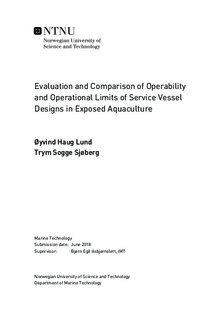| dc.description.abstract | The aim of this thesis is to evaluate and compare the operability and operational limits for three aquaculture service vessels at exposed locations by using a combination of hydrodynamic vessel response analysis and discrete-event simulation. The thesis is motivated by Norwegian aquaculture's gradual move towards more exposed locations due to a lack of available sheltered area. More exposure to winds, waves and currents increases the challenge of safely carrying out operations at sea. Studies have shown that additional insight into the limitations during service operations is needed to create operational decision support tools for exposed aquaculture.
An operational profile for the vessels, two catamarans and one monohull, was created by using information gathered from industry actors and used to construct a simulation model of the service vessels' work cycle. Relevant operational criteria were identified and implemented in hydrodynamic vessel response analysis to determine quantitative operational limits. The simulation model applied the operational limits and wave data from oceanographic buoys to determine the different vessels' long-term operability.
The results show that the operability of the vessels varies when subjected to different incoming wave directions. The design characteristics of the vessels also results in different operational limits and variations of limiting criteria, although roll, motion sickness incidence (MSI) and green water on deck were generally the more limiting criteria for all vessels. The catamarans were more impacted by MSI compared to the large monohull, but achieved a higher long-term operability, mainly due to the increased impact of the roll criteria on the monohull. The effect of different loading conditions was also notable. A study on the effect of wave-induced vessel motions on mooring line tension was also performed, though the tensions were not found to be significant.
The combination of vessel response calculations and discrete-event simulation gave results that demonstrated how the different vessels performed at different exposure, as well as which criteria that dictated their operability. This knowledge can aid the future design of service vessels for exposed aquaculture as well as provide knowledge needed to increase the capacity for operational decision support and planning. The simulation results have been considered to be within the expected range. However, the model and its outputs have not been validated. The results should therefore be interpreted as an indication rather than an exact portrayal of reality. Validation of the results is determined to be an important task for further work. In addition, an analysis of additional vessel designs and the implementation of current and wind effects are also found beneficial. | |

